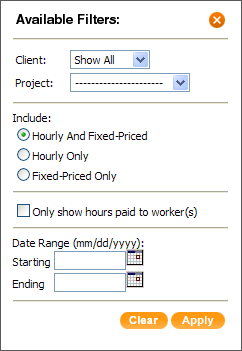There are many reasons to invoice clients for only some of the work that you and your workers have done. To read some sample scenarios, go to the Overview of the Billing & Invoice Process section.
You can always manually select and deselect which clients or entries you would like to be included in the next bill batch. Click the plus sign next to any client and you will see all the entries below that client. Select the ones you wish to include the next bill batch, and deselect the ones you wish to exclude.
Your selections will not be saved when you leave the Invoicing Screen. If you plan to use your selections to create a new bill batch, make sure to click

before you leave the Invoicing screen.
Sorting Unbilled Items
To sort, click on the header for any of the following fields: Client, Proj (Project), Worker, Description, Date, Orig Hours (Pre adjusted Hours), Adjust (Adjusted Amount), Total Hours, and Total (Total Dollars). The first time you click on a header, the list will be sorted in ascending alphabetical order (A->Z) based on the column you clicked, and the second time you click the same column, the list will sort in descending order. Every time thereafter, will toggle between the two.
If you are changing sorts between multiple columns, keep in mind that clicking on another column will reset all other columns to sort ascending the next time they are clicked.
Filtering Unbilled Items
The filter form allows you to narrow down the items you wish to bill based on common criteria. Generally you will want to use the filter form to bill a subset of items, but keep in mind that if you have exceeded the max number of records enabled for display, as set by you or another administrator in Performance Settings, you will need the filter to seek out older records.
 Filter
Filter Filter Form:

There are a variety of approaches you can take to billing. Below are some common methodologies to billing.
Approach 1 - Billing for specific clients: Using this approach, you wouldn't need the filter form at all. Simply select the clients you wish to bill in the Unbilled Items area, leaving the rest deselected.
Approach 2 � Billing for a specific type of item: Using this approach, you would want to filter on Billing Items Only, Fixed-Price Items Only, or Billing and Fixed-Price Item. You would also want to make sure to determine whether reimbursable expenses are included by choosing appropriate selection for the Include Reimbursable Expenses option.
Approach 3 � Billing clients after you've paid your worker: This option is useful if you want to pay your workers up front and then bill the clients. However, most will probably use this option in reverse and pay their workers after billing the client. The Unpaid Items Filter has the same option.
Approach 4 � Billing clients at regular intervals: Using this approach, you would filter based on a range of dates.
You don't have to invoice every time you create a bill batch. For example, you can create bill batches throughout the month, and then invoice at the end of the month, by going back through the bill batches and creating invoices.
As you can see there are many different approaches to organizing your billing, and the filtering features allows you to execute all of these approaches, as well as any other method you deem is appropriate for running your business. Below is a breakdown of all the filtering options:
Include: You must choose between Hourly And Fixed-Priced, Hourly Only, or Fixed-Price Items Only.
Include Reimbursable Expenses: Select this option if you only want fixed-price items that were originally marked as a reimbursable expense.
Only show hours paid to worker(s): This option is useful if you want to make sure not to bill a client unless you've paid your workers. Checking this option will eliminate any entries that have not been included in a Payroll Batch.
Client: Select a client from your list of active clients. Once selected, the Project drop-down box will fill with choices for the projects that client has.
Project: You will need to select a Client from the drop-down list. Once selected, the Project drop-down box will fill with choices for the projects that client has.
Date Range (mm/dd/yyyy): The Bill Date is a range option that allows you to enter a beginning date, an ending date, or both a beginning and end date. If you only enter a beginning date, it will show unbilled items beginning from that date, without limiting the end date. If you only put in an end date, it will show the unbilled item up until that date without limiting the beginning date. This option applies to the date of the item, not the date that the item was entered.